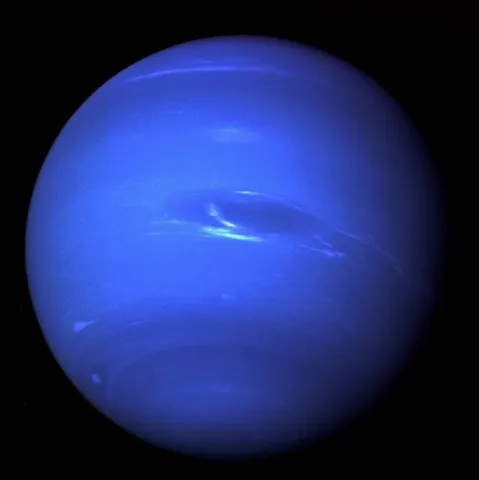
Neptune, the eighth and farthest planet from the Sun, is a majestic and mysterious world that has long fascinated astronomers and space enthusiasts alike. Named after the Roman god of the sea, Neptune is a gas giant, similar in composition to Uranus, with a deep blue hue that sets it apart from the other planets in our solar system. Its striking color is a result of the absorption of red light by methane in its atmosphere, and the planet is renowned for its powerful winds, the fastest recorded in the solar system.
History and Mythology
Neptune was discovered relatively recently, on September 23, 1846, by Johann Galle and Heinrich d'Arrest, who used mathematical predictions made by Urbain Le Verrier and John Couch Adams to locate the planet. Unlike the other planets visible to the naked eye, Neptune was discovered through calculations rather than direct observation, making it the first planet found in this manner.
In Roman mythology, Neptune was the god of the sea, equivalent to the Greek god Poseidon. The planet's name reflects its deep blue color, reminiscent of the ocean, and its association with the god of the sea. The discovery of Neptune is considered one of the great achievements of 19th-century astronomy, marking the first time a celestial body was found through mathematical predictions.
Moons of Neptune
Neptune has 14 known moons, with Triton being the largest and most intriguing. Triton is unique because it orbits Neptune in the opposite direction of the planet's rotation, a phenomenon known as a retrograde orbit. This suggests that Triton may have been captured by Neptune's gravity rather than forming in orbit around the planet. Triton is geologically active, with geysers that spew nitrogen gas, and it has a surface covered in a mixture of water ice and frozen nitrogen.
Other notable moons include Nereid, which has one of the most eccentric orbits of any moon in the solar system, and Proteus, the second-largest moon of Neptune, which is irregularly shaped and heavily cratered.
Statistics
- Orbital period: 164.8 Earth years
- Day length: 16.11 hours
- Average distance from Sun: 4.5 billion kilometers (2.8 billion miles)
- Diameter: 49,528 kilometers (30,598 miles)
- Mass: 17 times that of Earth
- Atmosphere: Hydrogen, helium, methane
- Temperature: Average -214°C (-353°F)
Probes That Have Visited Neptune
Only one spacecraft has visited Neptune—NASA's Voyager 2. Launched in 1977, Voyager 2 conducted a flyby of Neptune on August 25, 1989. During this close encounter, Voyager 2 provided the first detailed images of Neptune and its moons, revealing the planet's dynamic atmosphere, including the Great Dark Spot, a massive storm system similar to Jupiter's Great Red Spot. Voyager 2 also discovered Neptune's faint ring system and provided invaluable data on Triton, including the discovery of active geysers on its surface.
Fun Facts
- Neptune's winds can reach speeds of up to 2,100 kilometers per hour (1,300 miles per hour), the fastest in the solar system.
- The Great Dark Spot, discovered by Voyager 2, disappeared later, and new spots have since appeared, highlighting the planet's changing atmosphere.
- Neptune has a faint ring system, consisting of five main rings named after astronomers who made significant contributions to Neptune's study.
- Despite being farther from the Sun than Uranus, Neptune is warmer, likely due to internal heat sources.
Plans to Visit
As of now, there are no immediate plans for a dedicated mission to Neptune, though the idea has been discussed within the scientific community. Potential future missions could include orbiters or probes designed to study Neptune's atmosphere, rings, and moons in greater detail. Such a mission would provide a wealth of knowledge about this distant planet and its complex system.
The discovery and exploration of Neptune remain a testament to human curiosity and the drive to explore the unknown. As technology advances, the possibility of returning to Neptune and uncovering more of its secrets becomes increasingly likely, promising to shed light on one of the most enigmatic worlds in our solar system.
